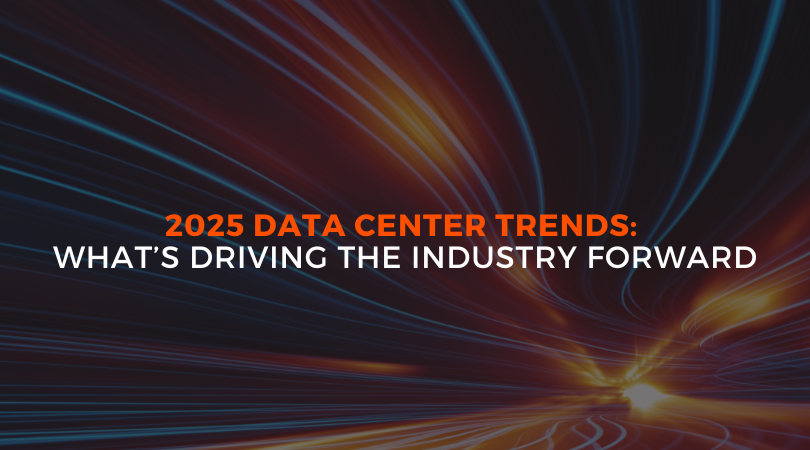2025 Data Center Trends: What’s Driving the Industry Forward
For those of us managing critical infrastructure, staying ahead of the curve is no longer just a strategy—it’s a necessity. With cloud adoption, AI, and energy efficiency at the forefront, understanding these emerging trends is crucial to navigating the challenges and seizing the opportunities the future holds. In this post, we’ll explore the top data center trends you should be watching in 2025 to ensure your infrastructure remains resilient, efficient, and competitive.
1. Liquid Cooling: The Future of Thermal Management
As computational power increases and hardware becomes more dense, traditional air cooling methods are reaching their limits. Liquid cooling technology—once considered a niche solution—is now becoming a mainstream choice for modern data centers. In 2025, we can expect widespread adoption of liquid cooling systems, which are far more efficient than air-based cooling in handling higher heat loads. These systems utilize water or specialized fluids to remove heat directly from the server components, ensuring optimal performance even under extreme conditions.
Why This Matters:
- More efficient cooling means reduced energy consumption and lower operating costs.
- Liquid cooling can extend the life of your equipment by preventing thermal stress and overheating.
- As data centers grow in density, this method becomes essential for maintaining performance without the massive energy demands of traditional air cooling.
2. Edge Computing: The Decentralization of Data
The growing need for real-time data processing is driving the rapid expansion of edge computing. By moving data processing closer to the source—whether it’s IoT devices, autonomous vehicles, or smart cities—edge computing reduces latency and alleviates bandwidth congestion on central data centers. For organizations striving to deliver low-latency services, edge computing will be an integral part of their infrastructure strategy.
Why This Matters:
- As data processing moves to the edge, data centers will play a more critical role in enabling decentralized networks.
- Edge infrastructure supports real-time decision-making in mission-critical applications, from healthcare to transportation.
- With 5G networks coming online, the synergy between edge computing and mobile networks will further drive innovation.
3. Sustainability: Green Data Centers Take Center Stage
Environmental responsibility has never been more important. Data centers are responsible for a substantial portion of global energy consumption, and as the demand for digital services grows, so does the environmental impact. By 2025, sustainability will be a key driver of data center design. Leading-edge data centers will continue to transition to renewable energy sources—such as wind, solar, and geothermal—and adopt more energy-efficient technologies to reduce carbon footprints.
Why This Matters:
- Sustainability isn’t just a corporate responsibility; it’s becoming a competitive advantage. Companies that invest in green initiatives will attract eco-conscious clients and align with regulatory requirements.
- Renewable energy is becoming more affordable and accessible, making it a viable long-term investment for data center operations.
- Green data centers are not just about reducing emissions—they’re about lowering operating costs, improving efficiency, and positioning businesses as leaders in environmental stewardship.
4. AI-Driven Automation: Managing Complexity with Intelligence
As the complexity of data center operations increases, so does the need for smarter management tools. Artificial intelligence and machine learning will play an increasingly important role in automating data center operations. From predictive maintenance and workload optimization to energy efficiency and security, AI will streamline operations and improve performance. In 2025, AI-powered systems will be able to anticipate potential issues before they occur, minimizing downtime and maximizing efficiency.
Why This Matters:
- AI reduces operational costs by automating routine tasks, enabling human resources to focus on strategic priorities.
- Predictive maintenance powered by AI can detect and resolve issues before they lead to costly downtime or equipment failures.
- Data centers will be able to dynamically adjust resources in real-time based on demand, reducing waste and optimizing energy consumption.
5. 5G Integration: Preparing for the Data Explosion
The rollout of 5G technology is set to revolutionize data center operations. With ultra-low latency and incredibly high bandwidth, 5G will drive the proliferation of IoT devices, autonomous systems, and data-intensive applications. In 2025, we’ll see more data centers positioned to support 5G connectivity, enabling faster processing speeds and enhanced mobile connectivity.
Why This Matters:
- 5G will generate unprecedented volumes of data, placing immense pressure on data center capacity and infrastructure. Data centers must be prepared to handle this influx while maintaining high performance and low latency.
- The ability to support real-time data processing is crucial for industries like manufacturing, healthcare, and logistics, where decisions need to be made in milliseconds.
- Data centers that are 5G-ready will unlock new revenue streams by enabling applications and services that are currently unfeasible with existing network technologies.
6. Quantum Computing and Advanced Security
Quantum computing is on the horizon, and it will radically change the landscape of data security. With the potential to break current encryption protocols, quantum computing will necessitate a shift in how we approach data protection. By 2025, we expect quantum-safe encryption methods to be integrated into data center security strategies, ensuring that critical infrastructure remains secure in the age of quantum threats.
Why This Matters:
- The ability to secure sensitive data in the face of quantum threats is paramount. By implementing quantum-resistant encryption today, data centers will be prepared for the challenges of tomorrow.
- With increasingly sophisticated cyber threats, advanced security measures will be necessary to safeguard against data breaches and ensure compliance with industry regulations.
- Quantum computing also has the potential to enhance data processing capabilities, offering new opportunities for data centers to innovate.
7. Modular and Containerized Data Centers: Flexibility and Scalability
The need for flexible, scalable infrastructure is pushing the adoption of modular and containerized data centers. These pre-configured units offer a faster, more cost-effective way to scale data center operations without the need for large-scale construction projects. By 2025, modular solutions will become a mainstream choice for organizations seeking to quickly expand their infrastructure to meet growing demands.
Why This Matters:
- Modular data centers can be deployed quickly, allowing businesses to scale operations rapidly in response to changing market conditions.
- Containerized solutions offer the flexibility to move and reconfigure infrastructure, reducing capital expenditure and risk.
- As businesses increasingly operate in hybrid cloud environments, the ability to deploy modular data centers in strategic locations will provide them with the agility they need.
8. Hybrid Cloud: The New Normal
Hybrid cloud infrastructure is quickly becoming the preferred model for businesses seeking to balance control with flexibility. By 2025, hybrid cloud environments will be fully integrated into data center operations, allowing businesses to optimize workloads between on-premises data centers, private clouds, and public clouds. This approach enables enterprises to meet regulatory requirements, improve security, and benefit from the scalability of the public cloud.
Why This Matters:
- Hybrid cloud models allow organizations to keep sensitive data on private servers while taking advantage of the scalability of public cloud resources for less critical workloads.
- This flexibility will drive operational efficiency and cost savings by optimizing workloads based on business needs.
- As cloud computing becomes the backbone of digital transformation, data centers must evolve to seamlessly integrate with hybrid cloud models.
Preparing for the Future of Data Centers
The convergence of edge computing, AI-driven automation, sustainability, 5G, and quantum computing is reshaping how data centers operate, scale, and innovate. For businesses in the critical infrastructure space, staying ahead of these trends will be crucial to maintaining a competitive edge and ensuring long-term success. By embracing these advancements and preparing for the next generation of challenges, we can build smarter, more sustainable, and more resilient data centers that are ready for the future.

